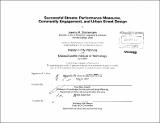Successful streets : performance measures, community engagement, and urban street design
Author(s)
Steinemann, Jeremy R
DownloadFull printable version (32.42Mb)
Other Contributors
Massachusetts Institute of Technology. Dept. of Urban Studies and Planning.
Advisor
Eran Ben-Joseph.
Terms of use
Metadata
Show full item recordAbstract
Over the past decade, local transportation agencies have increasingly re-designed urban arterials, their cities' major surface streets, to better accommodate a wide range of users. At the same time, a growing number of agencies are using performance measurement, the tracking and reporting of specific transportation-related variables, to evaluate and document their impacts. This report attempts to understand the role that performance measurement plays in design decision-making for urban arterial streets. First, the report examines how the selection and prioritization of performance measures shape urban arterial forms. While agencies in the mid-20th Century prioritized automobile performance in arterial design, present-day agencies attempt to balance performance across a broader range of street users and performance goals. Second, the report explores how local agencies can use performance-based planning for urban arterial projects at the same time as they engage in community-focused design processes. Research in transportation policy defines performance-based planning as a framework for agencies to use performance goals and measurement to guide decision-making. Existing research largely neglects the use of performance-based planning for project-level decisions and local transportation agencies. Since performance measurement systems hold agencies accountable to well-defined goals, performance-based planning may have value for both stakeholders and local officals in urban arterial design processes. To understand the potential role of performance-based planning for project-level design, this report examines four cases of urban arterial design: two in New York City (Prospect Park West in Brooklyn and 34th Street in Manhattan), and two in Portland, OR (North Williams Avenue and East Burnside). The cases were chosen because, in each, local officials faced community conflict about design and employed some form of performance measurement. The case study analysis finds that agencies can use performance-based planning to both guide design decisions and to actively engage community stakeholders. Among the cases considered, most employed only some features of performance-based planning, primarily to evaluate impacts and to make modifications to preliminary designs. One case, North Williams in Portland, was unique, however, in using a complete form of performance-based planning as a tool to increase participation by community stakeholders in the design process. Building upon the lessons from North Williams and the other cases, this report recommends a new framework for performance-based planning that attempts to empower stakeholders to participate in design decision-making, but recognizes that performance-based planning alone cannot resolve community conflicts.
Description
Thesis (M.C.P.)--Massachusetts Institute of Technology, Dept. of Urban Studies and Planning, 2012. Cataloged from PDF version of thesis. Includes bibliographical references (p. 171-181).
Date issued
2012Department
Massachusetts Institute of Technology. Department of Urban Studies and PlanningPublisher
Massachusetts Institute of Technology
Keywords
Urban Studies and Planning.